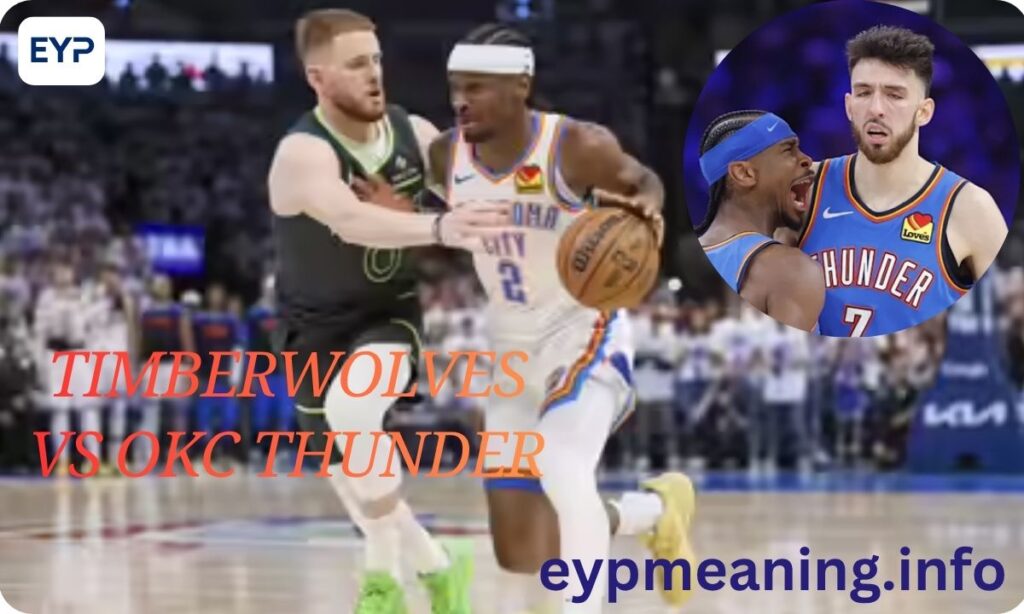The 2025 Western Conference Finals delivered one of the most electrifying playoff series in recent NBA history. The matchup between the Minnesota Timberwolves and the Oklahoma City Thunder showcased the future of basketball,two young, dynamic teams hungry for championship glory. The Thunder won the series 4-1, advancing to the NBA Finals behind Shai Gilgeous-Alexander’s stellar performances and exceptional team play.
Game 1: Thunder Take Early Lead
The series opener in Oklahoma City set the tone for what was to come. Playing in front of their passionate home crowd, the Thunder came out with intensity and purpose, immediately establishing their presence on both ends of the floor. The atmosphere was electric as fans sensed this young team was ready to make a statement on the biggest stage.
Dominant Performances
Shai Gilgeous-Alexander orchestrated the Thunder’s offense with surgical precision, finishing with 31 points, 6 rebounds, and 7 assists. His ability to control the tempo, break down defenders, and create scoring opportunities for teammates was on full display. SGA attacked the basket relentlessly, drawing fouls and converting at the free-throw line with remarkable efficiency.
Chet Holmgren proved why he’s one of the most versatile big men in the league, contributing 18 points, 9 rebounds, and 3 blocks. His seven-foot frame and mobility created matchup nightmares for Minnesota’s frontcourt. Holmgren protected the rim, stretched the floor with his shooting, and made smart decisions in transition.
Jalen Williams added 16 points, 8 rebounds, and 5 assists, showcasing the Thunder’s depth and balanced scoring. His all-around game complemented the star power of SGA, as Oklahoma City demonstrated they could hurt opponents in multiple ways.
Minnesota’s Response
For the Timberwolves, Anthony Edwards led the charge with 27 points, 5 rebounds, and 4 assists. His athleticism and scoring ability kept Minnesota competitive, but he lacked sufficient support. Karl-Anthony Towns contributed 19 points and 8 rebounds, but the Timberwolves struggled to establish consistent offensive rhythm against Oklahoma City’s aggressive defense.
The defining factor in Game 1 was turnovers. Minnesota’s 18 turnovers led to easy transition baskets for the Thunder, who converted defensive stops into fast-break points with devastating efficiency. The Thunder’s defensive pressure forced rushed decisions and disrupted the Timberwolves’ offensive flow, resulting in a comfortable victory and a crucial 1-0 series lead.
Game 2: Edwards Fights Back but OKC Stays Strong
Game 2 presented a different challenge for the Thunder. Minnesota adjusted their defensive scheme, focusing specifically on limiting Shai Gilgeous-Alexander’s penetration and forcing other players to beat them. The strategy showed promise early, but Oklahoma City’s depth proved too overwhelming.
Adjustments and Counter-Adjustments
SGA adapted to Minnesota’s defensive attention, recording 28 points and 8 assists while involving his teammates more frequently. His basketball IQ shined as he recognized when to attack and when to facilitate, keeping the Timberwolves’ defense off-balance throughout the game.
Jalen Williams stepped up significantly with 21 points and 7 rebounds, showing he could be a secondary scoring option when needed. Chet Holmgren dominated the glass with 16 points, 10 rebounds, and 2 blocks, controlling the paint and providing second-chance opportunities.
Edwards’ Brilliance
Anthony Edwards delivered one of his finest playoff performances, exploding for 32 points, 6 rebounds, and 3 steals. His speed, power, and fearlessness attacking the basket were impressive to watch. Edwards repeatedly got to the free-throw line, showing aggression and determination to keep his team competitive.
Julius Randle provided valuable support with 20 points and 4 rebounds, giving Minnesota a much-needed secondary scoring punch. However, the Timberwolves’ bench struggled to match Oklahoma City’s production, creating a crucial disparity in overall team output.
The fourth quarter proved decisive. With the game hanging in the balance, the Thunder executed their half-court offense with precision, getting quality shots and converting at critical moments. Their superior ball movement and patient shot selection contrasted with Minnesota’s tendency to force difficult attempts. Oklahoma City secured a hard-fought victory, taking a commanding 2-0 series lead back to Minneapolis.
Game 3: Timberwolves Show Their Power
Facing elimination pressure with their season on the line, the Timberwolves returned home determined to change the series narrative. The Target Center crowd created an intimidating atmosphere, and Minnesota fed off that energy from the opening tip.
Minnesota’s Statement Game
This game belonged to the Timberwolves from start to finish. They came out with unprecedented intensity, attacking Oklahoma City’s defense relentlessly and executing their game plan to perfection. The result was a stunning 143-101 blowout victory—the largest margin of the series and one of the most dominant playoff performances of the season.
Anthony Edwards orchestrated the demolition with 30 points, 9 rebounds, and 6 assists. Julius Randle attacked the paint aggressively, scoring 24 points with 7 rebounds. Mike Conley, the veteran point guard, controlled the tempo brilliantly with 15 points and 8 assists, setting up teammates and hitting timely three-pointers.
Thunder’s Struggles
For Oklahoma City, nothing went right. Shai Gilgeous-Alexander was limited to just 22 points and 6 assists as Minnesota’s defense swarmed him with double-teams and aggressive help defense. Chet Holmgren managed only 14 points and 5 rebounds as the Timberwolves pushed the pace and prevented the Thunder from establishing their defensive structure.
The Timberwolves’ defensive game plan was exceptional. They forced the Thunder into contested shots, crashed the defensive glass to prevent second-chance opportunities, and pushed the ball in transition to exploit Oklahoma City’s slower defensive rotations. The 42-point victory sent a clear message: this series wasn’t over, and the Timberwolves were capable of matching the Thunder’s intensity.
Game 4: Shai’s 40-Point Masterclass
Game 4 became an instant classic—a back-and-forth battle that came down to the final seconds. Both teams understood the stakes: a Minnesota win would tie the series, while an Oklahoma City victory would put them on the brink of the NBA Finals.
Individual Brilliance
Shai Gilgeous-Alexander delivered a performance for the ages, scoring 40 points with 10 rebounds and 9 assists—narrowly missing a triple-double while carrying his team to victory. His shot-making was extraordinary, hitting contested jumpers, converting difficult layups through traffic, and knocking down clutch free throws when the game was on the line.
SGA’s fourth-quarter performance was legendary. With Minnesota threatening to steal the game, he scored 15 points in the final period, including the game-winning basket with under 10 seconds remaining. His ability to rise to the occasion and deliver when it mattered most showcased true superstar mentality.
Jalen Williams contributed 22 points and 6 rebounds, providing crucial scoring when the Timberwolves focused their defensive attention on SGA. Chet Holmgren added 19 points and 4 blocks, altering shots at the rim and creating defensive stops at critical junctures.
Edwards’ Valiant Effort
Anthony Edwards matched SGA’s intensity with 28 points and 5 assists, refusing to let his team go quietly. His competitive fire kept Minnesota within striking distance throughout the contest. Julius Randle added 18 points and 8 rebounds, battling in the paint against Oklahoma City’s length.
The final sequence epitomized the game’s drama. With the score tied at 126, SGA drove baseline, absorbed contact, and finished a difficult reverse layup while drawing a foul. He missed the free throw, but the Thunder secured the rebound and ran out the clock. The 128-126 victory gave Oklahoma City a 3-1 series lead and put them one win away from their first Finals appearance in over a decade.
Game 5: Thunder Close Out the Series
Returning to Oklahoma City with a chance to clinch, the Thunder played with the poise and confidence of a championship-caliber team. The home crowd created deafening noise, and the players delivered a performance worthy of the moment.
Dominant Closeout
From the opening tip, Oklahoma City’s intent was clear: finish the series decisively and avoid giving Minnesota any hope. They executed their game plan flawlessly, building an early lead and never allowing the Timberwolves to mount a serious comeback threat.
Shai Gilgeous-Alexander orchestrated another masterful performance with 34 points, 7 rebounds, 8 assists, and 2 steals. His leadership and scoring touch ensured Oklahoma City maintained control throughout. Every time Minnesota threatened to cut the deficit, SGA responded with crucial baskets or assists that restored the Thunder’s cushion.
Chet Holmgren was phenomenal with 22 points, 7 rebounds, and 3 blocks. His defensive presence protected the rim while his offensive versatility kept Minnesota’s defense stretched. Jalen Williams added 19 points, 8 rebounds, and 5 assists, proving once again that Oklahoma City’s supporting cast could deliver in big moments.
Minnesota’s Final Stand
The Timberwolves fought valiantly despite facing elimination. Julius Randle led Minnesota with 24 points and 5 rebounds, showing toughness and determination until the final buzzer. Anthony Edwards, clearly exhausted from carrying the offensive load throughout the series, managed 19 points and 6 rebounds.
Minnesota’s offense struggled to generate quality shots against Oklahoma City’s suffocating defense. The Thunder held the Timberwolves to just 94 points—well below their season average—by protecting the paint, contesting three-pointers, and forcing difficult attempts.
The final score of 124-94 didn’t fully capture Minnesota’s effort, but it reflected Oklahoma City’s dominance when it mattered most. As the final buzzer sounded, the Thunder celebrated their Western Conference championship and their berth in the NBA Finals—a remarkable achievement for such a young team.
Series Summary: What Made OKC Win?
The Thunder’s 4-1 series victory wasn’t accidental. Several key factors contributed to their success and exposed the differences between these two talented teams.
Balanced Scoring Attack: Unlike Minnesota’s heavy reliance on Anthony Edwards, Oklahoma City could hurt opponents in multiple ways. SGA was the primary option, but Holmgren, Williams, and role players consistently contributed, making it impossible for defenses to key solely on one player.
Defensive Excellence: The Thunder’s defense was the series’ defining characteristic. They limited Minnesota’s scoring near the basket, forced turnovers with aggressive ball pressure, and communicated seamlessly on rotations. Holmgren’s rim protection discouraged drives, while perimeter defenders fought through screens and contested shots.
Rebounding Dominance: Oklahoma City controlled the glass on both ends, limiting Minnesota’s second-chance opportunities while creating their own. Holmgren’s size and positioning, combined with team-wide commitment to boxing out, gave the Thunder crucial extra possessions.
Composure Under Pressure: Even when Minnesota made runs or games got tight, the Thunder remained calm and executed their offense. They didn’t panic, force shots, or abandon their game plan—a testament to their coaching and veteran leadership.
Bench Production: Oklahoma City’s second unit consistently outperformed Minnesota’s reserves. The Thunder’s bench players brought energy, defended with intensity, and hit timely shots that maintained or extended leads.
Top Performers of the Series
Shai Gilgeous-Alexander (OKC): Averaging 31.0 points, 7.8 rebounds, and 8.2 assists, SGA was unquestionably the series’ best player. His 40-point Game 4 performance became a defining moment, showcasing his ability to dominate when stakes were highest.
Anthony Edwards (MIN): Despite the series loss, Edwards averaged 25.0 points and 6.0 rebounds while demonstrating his star potential. His Game 3 explosion kept Minnesota’s hopes alive and proved he can perform on the biggest stages.
Chet Holmgren (OKC): The young center averaged 17.5 points, 8.2 rebounds, and 3 blocks per game. His defensive versatility and offensive skills made him invaluable to Oklahoma City’s success.
Jalen Williams (OKC): Williams’ 18.0 points, 7.0 rebounds, and 5.0 assists per game exemplified his all-around contributions. His clutch plays and steady production provided crucial support.
Julius Randle (MIN): Averaging 21.0 points and 6.0 rebounds, Randle gave Minnesota reliable secondary scoring but couldn’t single-handedly overcome Oklahoma City’s depth.
Lessons from the Series
This series provided valuable insights about playoff basketball and what it takes to succeed at the highest level.
Teamwork Triumphs: Oklahoma City’s collective approach defeated Minnesota’s individual brilliance. While star power matters, consistent contributions from multiple players create sustainable success.
Defense Wins Championships: The Thunder’s defensive intensity and discipline were instrumental in their victory. Playoff basketball requires stopping opponents when games tighten and possessions become precious.
Youth Can Compete: Both teams showcased that young players can perform under immense pressure. The Thunder’s core handled the Western Conference Finals like veterans, proving age isn’t always a determining factor.
Depth Matters: In a seven-game series grind, having reliable bench players becomes crucial. Oklahoma City’s superior depth allowed them to maintain intensity and quality play throughout games.
Experience Accelerates Growth: While Minnesota showed promise, they’ll benefit from this playoff experience. Learning how to handle adversity, make adjustments, and maintain composure comes from going through battles like this series.
What’s Next for Both Teams?
Oklahoma City Thunder: The Thunder advanced to the NBA Finals brimming with confidence and momentum. Their young core—SGA, Holmgren, and Williams—positioned them as contenders for years to come. The Finals experience, regardless of outcome, would provide invaluable lessons for future championship pursuits.
The Thunder’s front office deserves credit for building through the draft, developing young talent, and creating a winning culture. Their patient approach paid dividends, and the franchise’s future appears incredibly bright.
Minnesota Timberwolves: Despite the disappointing series loss, Minnesota’s future remains promising. Anthony Edwards established himself as a legitimate superstar capable of leading a championship contender. His development and maturation suggest even better performances ahead.
Final Thoughts
The 2025 Western Conference Finals between the Timberwolves and Thunder delivered everything basketball fans could want: star performances, dramatic moments, competitive games, and a glimpse into the NBA’s future. While Oklahoma City emerged victorious, both teams demonstrated they’ll be forces in the Western Conference for years to come.
Shai Gilgeous-Alexander’s ascension to superstar status was complete, Anthony Edwards proved his franchise player credentials, and young talents like Chet Holmgren and Jalen Williams showed they belong among the league’s elite. The series showcased beautiful basketball,from Oklahoma City’s fluid ball movement to Minnesota’s explosive athleticism.
Frequently Asked Questions
Who won the Timberwolves vs OKC Thunder 2025 playoff series?
The Oklahoma City Thunder won the series 4-1, advancing to the NBA Finals.
Who was the best player in the series?
Shai Gilgeous-Alexander dominated the series, averaging 31.0 points, 7.8 rebounds, and 8.2 assists per game while delivering clutch performances throughout.
How many points did Anthony Edwards score in Game 3?
Anthony Edwards scored 30 points in Game 3, leading Minnesota to their only victory of the series—a dominant 143-101 win.
Did Chet Holmgren play well?
Yes, Holmgren was excellent throughout the series, averaging 17.5 points, 8.2 rebounds, and 3 blocks per game while providing elite rim protection.
What was the biggest win in the series?
Minnesota’s Game 3 victory was the most lopsided, with the Timberwolves winning 143-101—a 42-point margin.
Who had the most assists in the series?
Shai Gilgeous-Alexander led the series in assists, averaging approximately 8.2 assists per game.
How many games were close?
Game 4 was the closest contest, ending 128-126 in favor of Oklahoma City after a thrilling back-and-forth battle.
Which player surprised fans the most?
Jalen Williams impressed many with his consistent all-around play, composure in big moments, and ability to contribute in multiple ways.
When was the final game played?
Game 5 took place on May 28, 2025, at the Paycom Center in Oklahoma City.
What made OKC’s defense so effective?
The Thunder’s defense succeeded through quick rotations, excellent communication, help defense, and Chet Holmgren’s rim protection, which discouraged drives and altered shots consistently.






